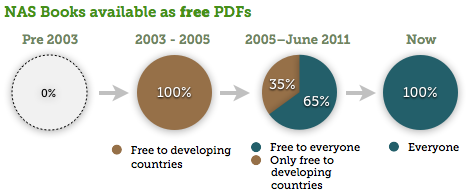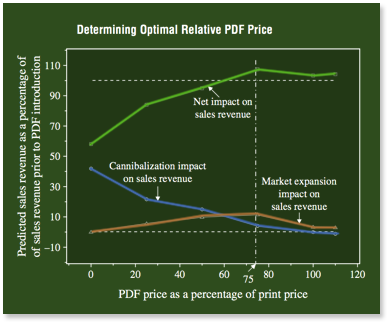Community Embraces New Word Game at Mid-Year Play Day This past Sunday, families at Takoma Park’s Seventh Annual Mid-Year Play Day had the opportunity to experience OtherWordly for the first time. Our educational language game drew curious children and parents to our table throughout the afternoon. Words in Space Several children gathered around our iPads […]
Read more![]() All publications from the National Academies Press (NAP) are now available for free as PDFs. NAP is the publishing arm of the National Academies, and publishes 200+ books a year on topics in science, engineering, and health.
All publications from the National Academies Press (NAP) are now available for free as PDFs. NAP is the publishing arm of the National Academies, and publishes 200+ books a year on topics in science, engineering, and health.
Making the PDFs free is the culmination of a decade of research and sales modeling on how to finance a nimble publishing house with paid print books, with enough spare revenue to allow free release of electronic books. Here’s the evolution:

Previously, NAP priced books, including PDFs, to generate enough income to be self-supporting. According to Barbara Kline Pope, executive director for NAP, in 1994, they started offering free full text online of all reports in page-by-page format, and in 2003, they began to make all of their full books available as free PDFs in developing countries (limited by IP address). Cannibalization of sales was not a concern because a negligible number of print sales were made in the 3rd world.
 Starting in 2001, they conducted careful research on buyers’ behaviors.
Starting in 2001, they conducted careful research on buyers’ behaviors.
To optimize sales, they found they should price PDFs at approx 75% the cost of a print book, and offer a bundle deal with both the print and PDF for 120% of the printed price. (See graph at right).
But what about going free? They found that if a buyer had a book in their shopping cart, and were offered a free PDF, 42% would jettison the printed book from the shopping cart and just take the free PDF. Mapping that data over all sales channels, they estimated a 33% substitution rate of free PDF for print. This corresponded to approx a loss of $1.9 million in revenue on printed books if they gave away free PDFs.
So to give away free PDFs, the press was going to have to find $1.9 million someplace else… The largest source of money was cost savings, and NAP slashed costs. Instead of print brochures, they now do the lion’s share of marketing online. They outsourced printing in 2004, and in August 2010 they also outsourced fulfillment and warehousing. They will continue to produce printed books for readers who like paper. They dropped unprofitable products, such as their line of science books for general audiences.
In the last two years, NAP’s revenue from book sales was ~$5 million, of which ~10% was from paid PDFs. Overall, the volume of print sales has been falling. If their estimates are right, they will immediately lose all of the PDF income, and lose at least another 1/3 to buyers who will no longer pay for a print copy. So book revenue for the coming year might be around $3m. Given their mission to broadly disseminate the work of the Academies, it is now a small price to pay for much wider reach: NAP hopes free downloads of the PDFs will boost eBook downloads from approx 700k/year now to over 3 million by 2013.
 In addition to PDFs, NAP also publishes to other eBook formats. They have ~200 books in Kindle, but the black & white format is not good for many of their books because of their color graphs and large tables. They have about the same number on the iPad, and are working on more. They have their entire list in Google e-books.
In addition to PDFs, NAP also publishes to other eBook formats. They have ~200 books in Kindle, but the black & white format is not good for many of their books because of their color graphs and large tables. They have about the same number on the iPad, and are working on more. They have their entire list in Google e-books.
The Academies are a suite of private, nonprofit organizations (National Academy of Sciences, National Academy of Engineering, Institute of Medicine, and National Research Council) created by congressional charters in the 19th and 20th centuries to advise the federal government on science, technology, and health policy. The NAS, NAE, and IOM are honorific organizations (members are not paid; it’s a high honor), and is supported by approx 1,100 paid staff. They conduct studies, convene meetings, and create publications. In 2010, the Academies had a total budget of $289 million, of which 84% came from U.S. agencies (e.g., the Department of Transportation) as grants and contracts, and the rest from foundations, nonprofit institutions, and state and local government. NAP’s budget is separate.
This model for providing free eBooks works for NAP, given their structure where the writing of the books are funded by the Academies’ research projects, but Ms. Pope cautions that it does not necessarily translate to other kinds of academic publishing, such as university presses.
Sources: NAS, NAP, and Pope’s 2009 paper in Marketing Science (PDF) with Kannan and Jain.


27 Jun 2011, 10:29 pm
Very impressive analysis/overview of the elements involved in the decisions (this from an internal veteran of those discussions).
Not absolutely accurate, but sufficiently so to understand the complexities of the decision to go "all in" with free PDFs.
Great infographics, too — well done!
30 Nov 2011, 12:35 pm
Nice information. Thank you.
30 Nov 2011, 12:46 pm
Computers and Information Technology section is now my favorite. Downloaded several books. Thank you. PDF is fine but how about .epub format? It’d better reading them on tablet PC.